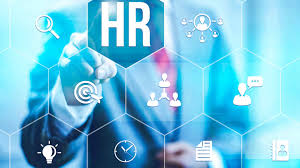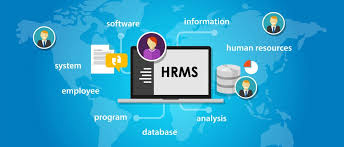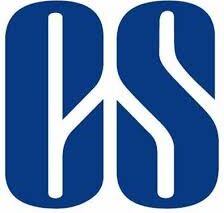Introduction Human Resource Information System
A Human Resource Information System (HRIS) is a system that revolutionizes the management of personnel-related information within an organization. It is a comprehensive software application designed to streamline and automate HR tasks, making it an indispensable tool for modern businesses.

Human Resource Information System acts as a centralized database for storing critical information about employees, including personal details, job histories, performance evaluations, benefits, and more. This system ensures data accuracy, accessibility, and security, replacing manual record-keeping methods that are prone to errors and inefficiencies.
One of the key advantages of a Human Resource Information System is its ability to enhance decision-making processes. By providing real-time access to a wide array of HR metrics and analytics, HR professionals can make informed decisions about recruitment, training, performance management, and resource allocation.
Furthermore, the Human Resource Information System simplifies administrative tasks like payroll processing, benefits management, and time tracking. This not only reduces the administrative burden on HR staff but also minimizes errors and ensures compliance with legal and regulatory requirements.
In addition to its administrative functions, the Human Resource Information System facilitates strategic HR planning. By analyzing data trends and patterns, organizations can identify areas for improvement, make data-driven decisions, and implement strategies to optimize workforce productivity and efficiency.
Overall, a Human Resource Information System is a powerful tool that empowers HR departments to operate more efficiently, make informed decisions, and contribute strategically to the organization’s overall success. Its ability to integrate and manage HR functions makes it a critical asset in today’s dynamic business environment.
Table of Contents
Top 05 Human Resource Information Systems
Certainly! Here are five top Human Resource Information Systems (HRIS) known for their effectiveness and features:

- BambooHR:
- BambooHR is a widely recognized HRIS known for its user-friendly interface and comprehensive features. It offers modules for HR functions such as recruitment, onboarding, performance management, and time tracking. It also provides robust reporting and analytics capabilities.
- Workday:
- Workday is a cloud-based HRIS known for its scalability and integration capabilities. It offers a wide range of HR functions including payroll, benefits administration, talent management, and workforce planning. It is particularly popular among large enterprises.
- ADP Workforce Now:
- ADP Workforce Now is a comprehensive HRIS known for its payroll and benefits administration capabilities. It also offers features for time and attendance tracking, talent management, and compliance management. It is suitable for both small and large organizations.
- Oracle Cloud HCM:
- Oracle Cloud HCM is an enterprise-grade HRIS that provides a suite of HR functions including global HR, talent management, payroll, and workforce management. It is known for its robust analytics and AI-driven insights.
- Namely:
- Namely is an HRIS designed for mid-sized organizations. It offers features for payroll processing, benefits administration, time tracking, and talent management. It is known for its intuitive user interface and customizable reporting.
These HRIS platforms are recognized for their reliability, functionality, and ability to streamline HR processes. When selecting an HRIS, it’s important for organizations to consider factors such as their specific needs, budget, and the scalability of the system to ensure it aligns with their business objectives.
Signs of Poor Human Resource Information System
A poorly functioning Human Resource Information System (HRIS) can have detrimental effects on HR operations and the overall functioning of an organization. Here are signs indicating a subpar HRIS:
- Inaccurate or Outdated Data:
- If the HRIS consistently contains outdated or inaccurate employee information, it indicates a lack of data integrity. This can lead to errors in payroll processing, benefits administration, and other critical HR functions.
- Inefficiencies in Data Entry:
- If HR staff members spend excessive time manually entering data into the system or encounter frequent system errors, it suggests that the HRIS lacks user-friendliness and automation capabilities.
- Lack of Integration with Other Systems:
- A disjointed HRIS that doesn’t integrate smoothly with other organizational systems (such as payroll, accounting, or performance management) can lead to duplicate data entry, inefficiencies, and potential errors.
- Limited Reporting and Analytics:
- If the HRIS struggles to generate meaningful reports or lacks advanced analytics capabilities, it hinders HR professionals’ ability to make data-driven decisions and identify trends for strategic planning.
- Security and Compliance Concerns:
- If the HRIS doesn’t have robust security measures in place to protect sensitive employee information, or if it fails to comply with data privacy regulations, it poses significant risks to data security and legal compliance.
- Inadequate Support and Training:
- When HR staff members struggle to use the HRIS due to a lack of training or inadequate support from the system provider, it can hinder the system’s effectiveness and lead to frustration among users.
- Difficulty in Customization:
- An inflexible HRIS that doesn’t allow for customization based on the organization’s specific needs and workflows may not align well with the company’s HR processes.
- Limited Scalability:
- If the HRIS struggles to handle the growing demands of an expanding organization, it may become overwhelmed and lead to performance issues or data management challenges.
- High Maintenance and Upgrade Issues:
- If the HRIS requires constant maintenance, experiences frequent downtime, or faces difficulties during upgrades, it can disrupt HR operations and lead to productivity losses.
- Low User Adoption Rates:
- When HR staff members and employees resist using the HRIS due to its complexity or lack of perceived value, it can impede the system’s effectiveness in streamlining HR processes.
Identifying these signs of a poor HRIS is crucial for organizations to take corrective measures. Whether it involves re-evaluating the current system, seeking additional training, or considering a new HRIS altogether, addressing these issues is essential for effective HR management.

What is a Human Resource Information Management System?
A Human Resource Information Management System (HRIMS) is a comprehensive software solution designed to streamline the management of HR-related tasks and processes within an organization. It serves as a centralized database for storing, organizing, and retrieving critical information about employees and HR functions.
Key features and functionalities of an Human Resource Information Management System HRIMS include:
- Employee Database:
- Human Resource Information Management System HRIMS serves as a centralized repository for storing detailed information about employees. This includes personal details, employment history, performance evaluations, training records, and more.
- Recruitment and Onboarding:
- It facilitates the recruitment process by tracking job openings, managing applicant profiles, and streamlining the onboarding process for new hires.
- Time and Attendance Tracking:
- HRIMS automates time tracking, helping HR professionals monitor attendance, track hours worked, and manage leave requests.
- Payroll and Benefits Administration:
- It supports payroll processing by automating tasks related to salary calculations, tax deductions, and benefit administration. This helps ensure accurate and timely compensation for employees.
- Performance Management:
- HRIMS allows for the tracking and management of employee performance evaluations, goal-setting, feedback, and development plans.
- Training and Development:
- It helps in planning, scheduling, and tracking employee training programs and professional development activities.
- Compliance and Reporting:
- HRIMS assists in ensuring compliance with legal and regulatory requirements by generating reports related to diversity, equal opportunity, labor laws, and more.
- Employee Self-Service (ESS) Portals:
- ESS portals provide employees with self-service options to access and update their personal information, view pay stubs, request leave, and more.
- Analytics and Reporting:
- HRIMS offers reporting and analytics tools that allow HR professionals to generate insights and make data-driven decisions about workforce management.
- Document Management:
- It enables the storage and retrieval of important HR documents, such as contracts, policies, and performance records.
- Integration Capabilities:
- Human Resource Information Management System HRIMS often integrates with other organizational systems like accounting, finance, and CRM, ensuring seamless data flow and reducing manual data entry.
- Security and Data Privacy:
- Human Resource Information Management System HRIMS employs robust security measures to protect sensitive employee information and ensure compliance with data privacy regulations.
Overall, a well-implemented Human Resource Information Management System HRIMS significantly enhances HR efficiency, accuracy, and compliance, enabling HR professionals to focus on strategic initiatives and contribute to the overall success of the organization.
Human Resource Information Management System Consist or Include?
A Human Resource Information Management System (HRIMS) consists of various components and features designed to streamline HR processes and improve efficiency. Let’s break down the key elements of a Human Resource Information Management System HRIMS using a corporate example for better understanding:
- Employee Database:
- In an Human Resource Information Management System
- HRIMS, there is a centralized database that stores detailed information about all employees. This includes personal details, contact information, job titles, department, and employment history.
- Recruitment and Onboarding Module:
- This module handles the recruitment process, allowing HR to post job openings, track applicants, and manage the onboarding of new hires.
- Time and Attendance Tracking:
- The HRIMS includes tools for monitoring employee attendance, tracking hours worked, and managing leave requests.
- Payroll and Benefits Management:
- This module automates payroll processing, handling tasks like salary calculations, tax deductions, and benefits administration.
- Performance Management:
- The HRIMS supports performance evaluations, goal-setting, feedback, and development planning.
- Training and Development:
- This component helps plan, schedule, and track employee training programs and professional development activities.
- Compliance and Reporting:
- The HRIMS generates reports to ensure compliance with legal and regulatory requirements, covering areas like equal opportunity, diversity, and labor laws.
- Employee Self-Service Portal:
- An ESS portal allows employees to access and update their personal information, view pay stubs, request leave, and more.
- Analytics and Reporting Tools:
- The HRIMS provides tools for HR professionals to generate insights and make data-driven decisions about workforce management.
- Security and Data Privacy Measures:
- The HRIMS includes robust security features to protect sensitive employee information and ensure compliance with data privacy regulations.
By incorporating these components, an HRIMS empowers HR departments in corporate settings to efficiently manage their workforce and contribute to the organization’s success. It streamlines processes, enhances data accuracy, and supports strategic HR initiatives.
How Human Resource Information Management System help an Organisation?
A Human Resource Information Management System (HRIMS) provides numerous benefits to an organization by enhancing HR operations and contributing to overall organizational success. Here are several ways in which an HRIMS helps an organization:
- Efficient Data Management:
- HRIMS centralizes employee data, making it easy to access, update, and maintain accurate records. This eliminates the need for manual record-keeping, reducing the risk of errors and ensuring compliance with legal and regulatory requirements.
- Streamlined Recruitment and Onboarding:
- HRIMS automates the recruitment process, allowing HR professionals to post job openings, track applicants, and manage onboarding efficiently. This leads to a more seamless and organized hiring process.
- Improved Time and Attendance Tracking:
- With HRIMS, tracking employee attendance, managing leave requests, and monitoring working hours become automated processes. This reduces administrative burden and ensures accurate timekeeping.
- Efficient Payroll Processing:
- HRIMS automates payroll tasks, such as salary calculations, tax deductions, and benefit administration. This leads to accurate and timely payroll processing, reducing errors and ensuring employee satisfaction.
- Enhanced Performance Management:
- HRIMS provides tools for setting performance goals, conducting evaluations, and offering feedback. This promotes a transparent performance management process and supports employee development.
- Facilitated Training and Development:
- The HRIMS helps in planning, scheduling, and tracking employee training programs and professional development activities. This ensures that employees have access to relevant learning opportunities.
- Compliance Management:
- HRIMS generates reports and alerts to help organizations ensure compliance with legal and regulatory requirements, reducing the risk of non-compliance penalties.
- Employee Self-Service Capabilities:
- An HRIMS often includes self-service portals, allowing employees to access and update their personal information, view pay stubs, and request leave. This empowers employees and reduces administrative overhead.
- Data-Driven Decision-Making:
- HRIMS provides advanced reporting and analytics tools that allow HR professionals to generate insights from HR data. This supports informed decision-making, enabling HR to contribute strategically to organizational goals.
- Enhanced Security and Data Privacy:
- HRIMS employs robust security measures to protect sensitive employee information. It ensures compliance with data protection laws, safeguarding against unauthorized access or breaches.
- Support for Strategic HR Initiatives:
- By automating routine HR tasks, HRIMS frees up time for HR professionals to focus on strategic initiatives like talent management, succession planning, and organizational development.
- Scalability and Adaptability:
- A well-designed HRIMS can grow with the organization, accommodating increased data and process demands as the company expands.
In summary, an HRIMS streamlines HR operations, enhances data accuracy, and empowers HR professionals to contribute strategically to organizational success. It plays a crucial role in improving HR efficiency, employee satisfaction, and overall business performance.
Difficulties Faced in Human Resource Information Management System?
Implementing and managing a Human Resource Information Management System (HRIMS) can come with its share of challenges. Here are some common difficulties faced in HRIMS:
- Integration Issues:
- Integrating the HRIMS with existing organizational systems (such as payroll, accounting, or performance management) can be complex and may require customizations to ensure seamless data flow.
- Data Migration and Cleansing:
- Transferring existing employee data into the HRIMS and ensuring its accuracy can be a time-consuming and delicate process. Data cleansing may be needed to rectify inconsistencies.
- Customization Complexity:
- Tailoring the HRIMS to meet the specific needs and workflows of an organization can be challenging, especially if the system lacks flexibility or requires extensive coding.
- User Adoption and Training:
- Ensuring that HR staff and employees are comfortable and proficient in using the HRIMS may require thorough training programs. Resistance to change can also be a barrier.
- Data Security and Compliance:
- Ensuring the HRIMS complies with data protection laws and regulations (such as GDPR, HIPAA) while safeguarding sensitive employee information can be a significant concern.
- Vendor Support and Maintenance:
- Depending on the HRIMS provider, obtaining timely support and updates may be challenging. Downtime during system upgrades can also disrupt HR operations.
- Cost Considerations:
- The initial investment in an HRIMS, as well as ongoing maintenance and subscription fees, can strain a company’s budget. Ensuring a return on investment (ROI) is crucial.
- Scalability Challenges:
- As an organization grows or undergoes changes, the HRIMS must be able to scale to accommodate the increased data and process demands. A system that lacks scalability may lead to performance issues.
- User Experience and Interface Design:
- A complex or unintuitive user interface can hinder user adoption and lead to inefficiencies. The HRIMS should be user-friendly to maximize its effectiveness.
- Dependency on Technology:
- Relying heavily on technology means that any technical issues or system outages can disrupt HR operations. Contingency plans must be in place to handle such situations.
- Upkeeping Data Accuracy:
- Maintaining the accuracy and relevance of data within the HRIMS requires ongoing effort, including regular audits and updates to employee information.
- Change Management and Culture Shift:
- Introducing an HRIMS may require a cultural shift within the organization. Overcoming resistance to new processes and technologies can be a significant challenge.
Understanding and proactively addressing these difficulties can help organizations successfully implement and manage an HRIMS, ultimately leading to more streamlined and efficient HR operations.
